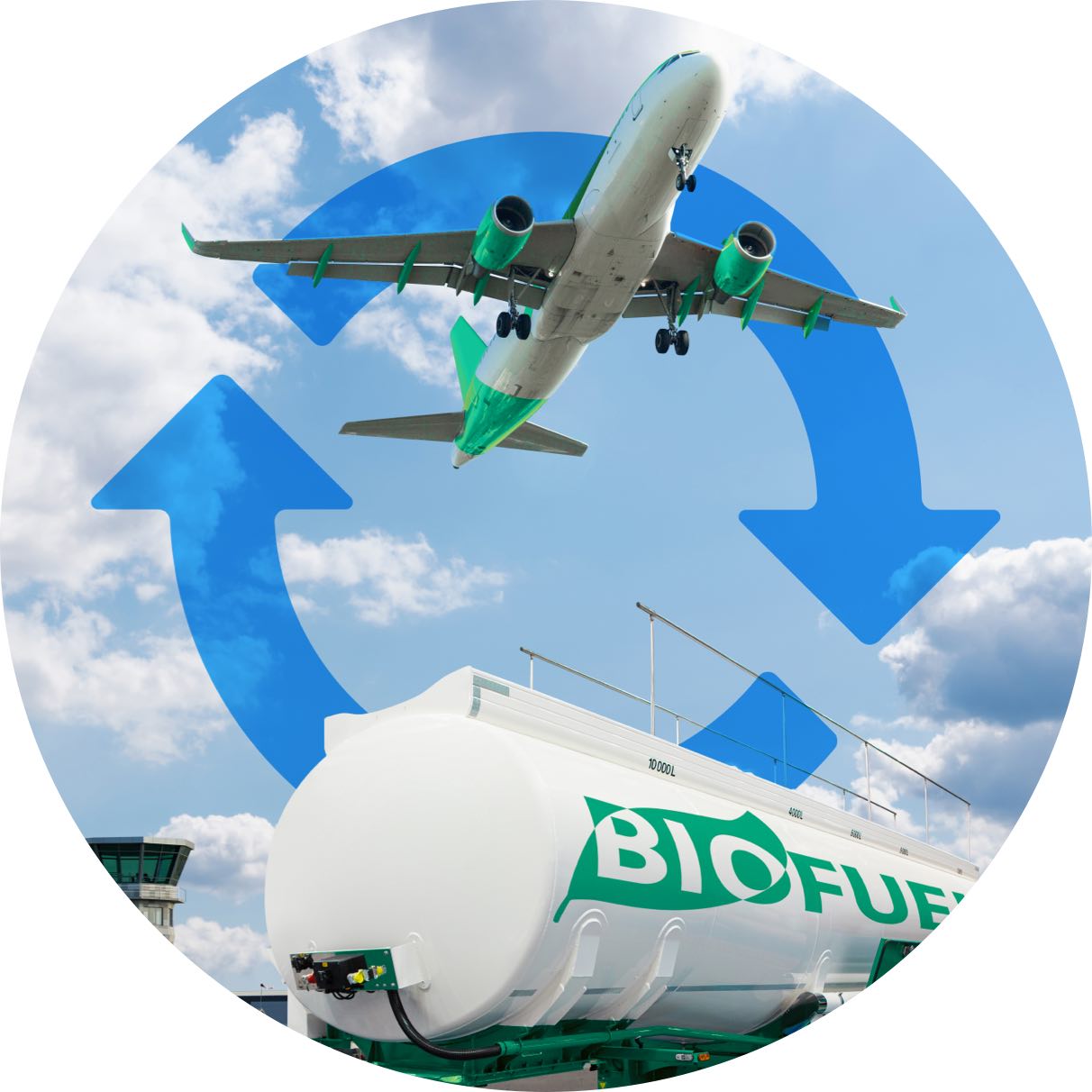What issue can we solve for you?
Type in your prompt above or try one of these suggestions
Suggested Prompt



Insights
The Top Challenges of Scaling Sustainable Aviation Fuel
The Top Challenges of Scaling Sustainable Aviation Fuel
Airlines are turning to sustainable aviation fuel (SAF) to reach net-zero carbon emissions. But how will brands balance its value with its cost?

Summary
- Sustainable aviation fuel (SAF) is the aviation industry’s biggest bet in hitting net-zero carbon emissions goals
- Some SAF fuel sources aren’t as sustainable as we think, and airlines will need to begin monitoring emissions across fuel producers to increase sustainability ROI
- Supply and demand is the #1 challenge for SAF, and manufacturers will need to increase production by 9000% to hit 3 billion gallons of SAF by 2030, U.S. President Joe Biden’s proposed target
- In order to succeed in implementing SAF, airlines need a centralized, cloud-based data management system to monitor carbon emissions, optimize fuel blend balance, forecast SAF usage, audit efficiency and avert potential government penalties
Sustaining industry growth while reducing carbon emissions requires airlines to rethink flight 101. In the search for solutions that move the needle, airlines and industry stakeholders have latched onto sustainable aviation fuel (SAF) or biofuel.
What is sustainable aviation fuel?
Unlike typical aviation fuel, SAF is made from a renewable hydrocarbon-based source which can reduce carbon emissions by 75% compared to traditional fossil-based jet fuel.
Global business and government leaders have touted SAF as the best opportunity today for meaningful reductions in air travel emissions, and many initiatives are underway to turn SAF into a reality for the industry. Several European countries are mandating airlines to use a certain percentage of SAF by 2030, and the U.S. Inflation Reduction Act has incentivized airlines with an increased tax credit. Within the private sector, international aviation organizations and global corporations have formed alliances, such as the Eco-Skies Alliance, to invest in biofuel production, carbon capture and sequestration and the purchase of SAF.
But how effective is SAF, and is it a realistic solution to the aviation industry’s goal of net zero?
That depends on how accurately airlines are able to analyze carbon emissions throughout the entire fuel lifecycle, as well as create sustainable fuel supply chains in order to strategically take advantage of tax credits and ensure a maximum decrease in overall GHG emissions for the industry.
“The challenge for airlines is being able to model and automate the end-to-end lifecycle of SAF to obtain visibility and take advantage of tax credits,” says Amit Singh, sustainable solutions lead at Publicis Sapient. “Understanding the overall Scope 3 emissions from partner manufacturers and determining a supply chain strategy, given that the SAF market is highly constrained, is crucial to ensuring the greatest impact in terms of sustainability and ROI.”
Amit Singh , Senior Director, Energy & Commodities
As airlines invest in this industry-changing strategy, it’s crucial to measure the variability in net carbon emissions from blended fuel compared to jet fuel across regions, manufacturers, and sources to successfully move toward realistic net-zero carbon emissions goals.
Sustainable aviation fuel is facing turbulence
While the discovery of this fuel option certainly simplifies the airline sustainability formula, its implementation leaves the potential to stumble.
There are seven key challenges within the aviation industry that need to be addressed to succeed in carbon-neutral growth:
- Carbon taxes
- Emission reduction mandates
- Regulatory reporting requirements for emissions
- Fuel cost risks
- Supply and demand risks
- Shifts in business and consumer sustainability preferences
- Investor interest in reducing emissions
However, one less obvious obstacle is the industry’s reliance on generation 1 biofuels, a less sustainable energy source for SAF.
Generation 1 and 2 biofuels
Biofuels are divided into three categories: Generation 1, Generation 2, and Generation 3, from the least to most environmentally advantageous.
A recent report from the non-profit U.S. Center for Biological Diversity points out that top SAF producers are using certain subsets of feedstocks (Generation 1 and 2) that aren’t as sustainable as many assume, particularly food-based feedstocks, wood biomass and forestry residues, used cooking oil, animal fats and manure. If the aviation industry exponentially grows its use of SAF to hit upcoming net-zero targets, this could unintentionally incentivize the production of these less sustainable biofuels and erode current sustainability efforts in these industries.
While Alder Fuels and other top SAF producers are moving toward a reliance on greener Generation 2 biofuels, such as harvested forestry waste and energy crops, there is still risk associated with a sudden mass increase in their production. Generation 3 biofuels, namely algae, are still in development and are far from large-scale supply.
Power-to-liquid fuel
Power-to-liquid fuel, also known as e-fuel or synthetic fuel, is another fossil fuel alternative far from mainstream adoption. If production were scaled, this fuel could diversify the SAF supply with its higher yield and smaller GHG footprint than other biofuels. This nascent technology has quickly gained traction through several initiatives across sectors, including United Airlines' promise to purchase at least 300 million gallons of e-fuel from production company Dimensional Energy.
SAF supply and demand
However, all of these fuels are still hitting the wall when it comes to supply and demand. Experts predict that SAF will only account for 65% of airline fuel in 2050, well under the U.S. goal of 100%. In order to come close to net-zero goals, airlines will need to significantly increase investment into production companies, fuel and research and development.
To face this challenge, the U.S. Department of Energy published a roadmap to successfully increase SAF supply to at least 3 billion gallons by 2030, a 9000% increase over the current 33 million gallons produced in 2021. The roadmap focuses on increased production of lipid-based cover crops to create SAF. As of 2020, cover crops made up just 1.7% of total cropland in the U.S.
What’s the cost of de-carbonization?
Another potential roadblock to airline adoption of SAF is the high cost, which many are attempting to mitigate through tax credits and other government incentives. President Biden’s 2022 Inflation Reduction Act, which extends the $1 per gallon biodiesel and renewable diesel blenders tax credit, includes a new $1.25 to $1.75 credit for years 2023-2024. The act also provides over $250 million in potential grant money for airlines to develop SAF.
“Depending on SAF life cycle analysis, if your fuel has produced higher greenhouse gas (GHG) levels than expected, you would probably get $1.25 per gallon as opposed to $1.75 in incentives and credits, which is a significant expense for U.S. airlines. This is why end-to-end lifecycle analysis, starting with fuel manufacturers, is crucial to achieving industry-wide sustainability goals,” says Singh.
In 2021, the EU proposed its version of a sustainability act that would mandate the use of synthetic fuel as well as impose a tax on jet fuel, something European airlines have avoided thus far. However, many airlines agree this is still not enough to meet sustainability targets, as the cost of SAF is 2 to 5 times more than regular jet fuels depending on the market.
Ultimately, airlines agree that this cost will have to partially transfer to the consumer, although airlines will need to figure out exactly what price hikes consumers will accept, how it will affect their bottom line and the necessary communication and marketing behind increases. IATA General Director Willie Walsh publicly stated that SAF is “an important issue, and ultimately [consumers] will be willing to pay.” Publicis Sapient research also suggests that some consumers are open to this idea. 1/4 of Gen Z and almost 1/3 of Millennials strongly agree that sustainability plays an important role in decisions about where and how they travel.
The ticket to net zero by 2030
Despite the complications of SAF production, consumers, airlines, and government agencies are motivated to hit the target of 10% by 2030.
However, there are a myriad of factors to balance across the SAF end-to-end lifecycle.
From raw materials to feedstock to packaging and manufacturing, the airline fuel lifecycle is complex and requires significant re-adjustments to decrease carbon and overall GHG emissions.
How can airlines shift supply chains and track carbon emissions?
“Creating a single source of truth for emissions forecasting, internal benchmarking, regulatory reporting, and even supply chain operations recommendations can help airlines reach their net zero goals in the most efficient way possible,” says Singh.
-
Publicis Sapient’s eMission Cloud View solution helps the aviation industry:
Monitor energy and emissions data at a glance
Work towards net zero across your enterprise
Achieve OPEX reductions of 10-15%
See energy efficiency improvements of 5-10%
Avert penalties with alerts when emissions come within 20% of regulatory limits
Provide governance reporting whenever needed
Easily present and review financial considerations for investors
Carry out smooth internal/external energy efficiency audits and assessments
Reveal the areas where risk mitigation is needed
Set emissions benchmarks across the enterprise
![]()
The solution can help manage the forecast of what is required based on certain targets. For specific reduction goals, airlines can optimize strategies based on constraints, like the number of flights, SAF production, cost or plane model, and then divide by different subregions down to the specific airport.
Reach out to Amit Singh to learn more about Publicis Sapient’s SAF solutions for the travel and hospitality industry.








